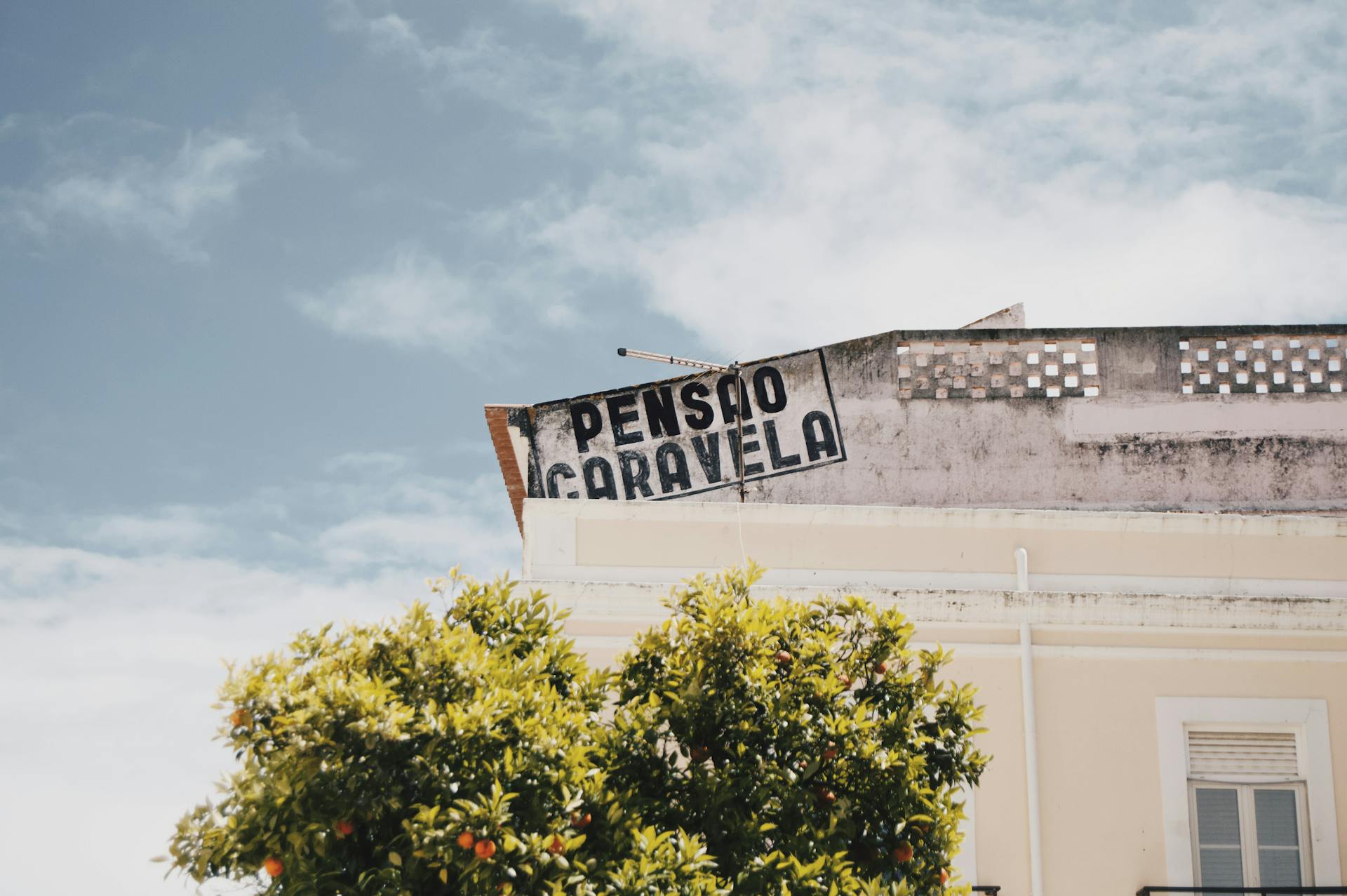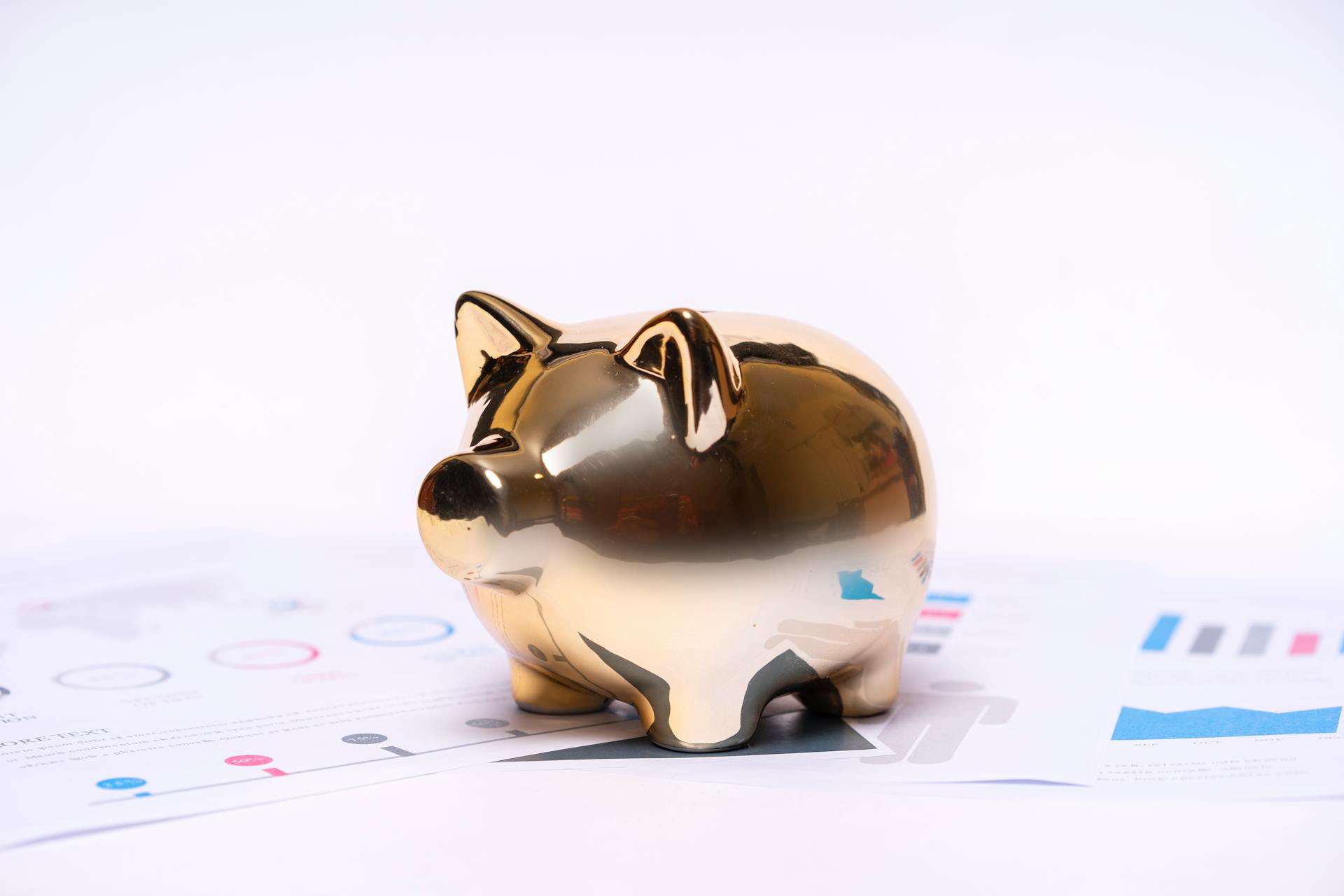
Pension fund solutions can help individuals plan for a secure retirement, providing a steady income stream and peace of mind.
A pension fund is a type of retirement account that pools money from multiple individuals to invest in a diversified portfolio, typically with the goal of providing a steady income stream in retirement.
Many pension funds offer a range of investment options, allowing individuals to choose the level of risk they're comfortable with, from conservative fixed income investments to more aggressive equity investments.
By investing in a pension fund, individuals can potentially earn higher returns than they would with a traditional savings account or other low-risk investments.
See what others are reading: Pension Fund Asset Allocation Trends
How It Works
A pension fund works by accumulating contributions from employers and sometimes employees, which are then invested to grow over time.
These contributions are used to provide retirement income for employees after their working life.
Pension funds are managed by state or private firms.
See what others are reading: United Nations Joint Staff Pension Fund
Employees receive benefits, typically calculated as a percentage of their average salary during their working years.
For instance, consider a scenario where a pension scheme offers a payment equivalent to 1% of an individual's average salary over the last five years of their employment for each year they served with the employer.
This means that if an employee worked for 35 years at the company and had an average final salary of $60,000, they would be entitled to an annual pension of $21,000.
One cannot usually take early withdrawals or loans from pension funds.
Public sector pensions, like the California Public Employees’ Retirement System (CalPERS), often include a cost-of-living escalator.
This means that the benefits paid by these pensions can increase over time to keep pace with inflation.
Private pension plans are regulated by federal laws such as the Employee Retirement Income Security Act (ERISA) and are insured by the Pension Benefit Guaranty Corporation (PBGC), which guarantees benefits if a pension plan fails.
A fresh viewpoint: Pension Fund Asset Allocation
ERISA
ERISA is a law that provides a framework for regulating private pension plans in the United States. It was enacted in 1974 to put pensions on a more solid financial footing.
ERISA requires employers to pay an annual premium to the Pension Benefit Guaranty Corporation (PBGC) for each participant in their pension plan. The PBGC acts as a pension insurance fund, guaranteeing that employees will receive retirement and other benefits if the pension plan fails.
In 2024, the maximum amount guaranteed for a 65-year-old retiree in a single-employer plan who takes their benefit as a straight life annuity is $7,107.95 per month. This is a significant amount that can help ensure a stable retirement income for many people.
ERISA does not cover public pension funds, which are regulated by state governments and sometimes state constitutions. This means that public pension funds are not protected by the PBGC, and taxpayers may be responsible for picking up the bill if a public employee plan is unable to meet its obligations.
Investing Money
Pension funds invest their money in a variety of assets, including stocks, bonds, real estate, and alternative investments. These investments are chosen to provide a stable and reliable source of retirement income for members.
ERISA, a law that governs pension plans, requires plan sponsors to operate as fiduciaries, putting their clients' interests ahead of their own. This means they must make prudent and diversified investments to prevent significant losses.
Pension funds traditionally split their assets among bonds, stocks, and real estate, but an emerging trend is to invest in alternative assets like private equity, hedge funds, and commodities. These investments can provide higher returns and greater diversity.
In recent years, many pension funds have shifted towards passive investment methods, focusing on index funds and exchange-traded funds (ETFs) that replicate market indices. This approach can help reduce costs and increase efficiency.
Some pension funds are also diversifying into alternative assets like commodities, high-yield bonds, and real estate. These investments can provide a hedge against market volatility and increase returns.
See what others are reading: Retail Money Market Funds
Direct investments in commercial properties like office buildings, warehouses, and industrial parks are also becoming more prevalent. This can provide a steady income stream and long-term appreciation in value.
Here are some examples of governments that have established public pension systems that are partially or fully funded by investments:
| Government | Pension System |
|---|---|
| Norway | The Norwegian Government Pension Fund Global (Oil Fund) |
| Singapore | The Central Provident Fund (CPF) |
| Canada | The Canada Pension Plan Investment Board (CPPIB) |
| Australia | The Australian Government's Future Fund |
| Sweden | The Swedish Pension System (Allmänna pensionssystemet) |
These governments are using investments to help ensure the long-term solvency of their pension programs. By diversifying and growing their pension fund assets, they aim to mitigate the risks of running out of money in the future as their populations age.
Types and Variations
There are two main types of pension plans: defined-benefit plans and defined-contribution plans. Defined-benefit plans specify exactly how much retirement income an employee receives once they retire, and employer contributions are often not capped at 25% of pay.
A defined-contribution plan, on the other hand, specifies exactly how much each party must contribute to a plan to receive an unknown amount at retirement. The administration cost of a defined-contribution plan is often lower than a defined-benefit plan.
Some companies offer both types of pension plans, and even allow participants to roll over 401(k) balances into defined-benefit pension plans.
Recommended read: Types of Private Investment Funds
Types

There are two main types of pension plans: the defined-benefit plan and the defined-contribution plan. These are the primary options for companies looking to offer retirement benefits to their employees.
A defined-benefit plan guarantees a specific monthly payment to employees after they retire, regardless of the performance of the underlying investment pool. The employer is liable for pension payments to the retiree for a dollar amount typically determined by a formula based on earnings and years of service.
The 401(k) plan is a type of defined-contribution pension plan, where employees make contributions, which may be matched to some degree by the employer. The final benefit to the employee depends on the investment performance of the plan.
Defined-benefit plans are often more expensive for companies to sponsor, but they provide a predictable benefit to employees. In contrast, defined-contribution plans are less expensive and shift the investment risk to the employee.
Here's a summary of the two main types of pension plans:
| Type of Pension Plan | Description |
|---|---|
| Defined-Benefit Plan | Employer guarantees a specific monthly payment to employees after retirement. |
| Defined-Contribution Plan | Employee contributions determine the benefit amount, which depends on investment performance. |
Both types of plans have their advantages and disadvantages, and companies must carefully consider their options when deciding which type of pension plan to offer their employees.
Public vs Private
Public pension funds are regulated under public sector law, while private pension funds are regulated under private sector law. This distinction can be blurry in some countries.
In the United States, local governmental bodies are subject to state laws that define classes of permitted investments and a minimum municipal obligation.
What Are the Advantages of Having
Having a pension fund offers tax benefits, including tax-deductible contributions and tax-free growth of your investments.
Employer contributions are a significant advantage, as they typically match a portion of your contributions, increasing the amount you save for retirement.
Pension funds are professionally managed by experienced asset managers who select and manage investments to maximize returns and minimize risk.
Diversification is key, with pension funds investing in asset classes such as stocks, bonds, and alternative investments like real estate and private equity.
This diversification helps reduce the overall risk of your portfolio and provides more stable returns over the long-term.
For another approach, see: Super Fund Tax
A pension fund can provide a steady stream of retirement income, with some plans offering a guaranteed income for life, giving you peace of mind and financial security.
Pension funds play a crucial role in ensuring economic stability by supporting large-scale investments and contributing to economic growth.
By investing in financial instruments such as stocks, bonds, and real estate, pension funds drive economic growth and create jobs.
Pension funds are also an effective way for organizations to attract and retain employees, providing them with a valuable benefit that ensures their financial well-being in retirement.
Here's an interesting read: Income Fund
Management and Governance
Pension funds are managed by experienced asset management companies that select and manage investments to maximize returns and minimize risk. These fund managers are responsible for overseeing the pension fund's operations and ensuring compliance with regulations.
Effective governance is crucial for pension funds to safeguard their retirement savings and meet future obligations to pensioners. The governance structure should clearly identify and separate operational and oversight responsibilities.
See what others are reading: Fund Governance
A governing body, accountable to pension plan members and beneficiaries, should be in place to ensure adherence to the terms of the arrangement and protect the best interest of plan members and beneficiaries. This governing body should meet minimum suitability standards to ensure a high level of integrity, competence, experience, and professionalism.
Pension fund managers have several key duties, including managing investment portfolios, managing risk, and monitoring market conditions. They must also communicate with pension fund members about investment strategies, performance, and other matters related to the pension fund.
Pension fund managers must ensure compliance with laws and regulations, report to regulatory agencies, and oversee the administration of the pension fund. This includes managing member accounts, processing contributions and distributions, and responding to member inquiries.
Broaden your view: What Hedge Fund Managers Do
Taxation and Regulation
Taxation and regulation play a crucial role in the pension fund system. Most employer-sponsored pension plans are qualified, meaning they meet Internal Revenue Code 401(a) and ERISA requirements, giving them tax-advantaged status for both employers and employees.
Contributions made by employees are taken out of their gross income, reducing their taxable income and the amount they owe to the IRS come tax day. This effectively reduces the employee's taxable income.
Funds placed in a retirement account grow at a tax-deferred rate, meaning no tax is due on the funds as long as they remain in the account. This allows employees to reinvest the full complement of dividend income, interest income, and capital gains, which can generate a much higher rate of return over the years before retirement.
Pension funds are regulated by government agencies such as the Securities and Exchange Commission (SEC) to ensure compliance with regulations and protect the interests of pension fund members. The Employee Retirement Income Security Act 1974 (ERISA) and The Pension Protection Act (PPA) are examples of regulations in the United States.
In the European Union, pension funds are regulated by Directive 2003/41/EC, also known as the IORP directive, which promotes long-term investment and better informs beneficiaries and members about their entitlements.
Suggestion: Mutual Fund Only Account Fidelity
Regulation
In the United States, pension plans are regulated mainly by The Employee Retirement Income Security Act of 1974 (ERISA). ERISA provides a framework for the regulation of employee pension plans.
The ERISA aims to put pensions on a more solid financial footing and established the Pension Benefit Guaranty Corporation (PBGC). The PBGC acts as a pension insurance fund, guaranteeing that employees will receive retirement and other benefits if the pension fails.
In 2006, The Pension Protection Act (PPA) was introduced, bringing new funding requirements for defined pension plans, as well as new rules for calculating plan assets and liabilities. These regulations help ensure that pension plans are operating in a sound financial condition.
The PBGC pays up to certain maximums, which can change from year to year. For example, in 2024, the maximum amount guaranteed for a 65-year-old retiree in a single-employer plan who takes their benefit as a straight life annuity is $7,107.95 per month.
Pension funds in the European Union are regulated by Directive 2003/41/EC, also known as the IORP directive. This directive was recast and adopted in December 2016, aiming to promote long-term investment via occupational pension funds.
Is Taxable?
Pension funds are usually subject to taxation. This means you'll have to pay taxes on the money you withdraw from your pension plan.
The type of pension plan you have determines the tax treatment. If you have an employer-sponsored plan that meets Internal Revenue Code 401(a) and ERISA requirements, it's considered a qualified plan.
Contributions made to a qualified pension plan come off the top of your paycheck, reducing your taxable income. This means you'll owe less to the IRS come tax day.
Funds in a retirement account grow at a tax-deferred rate, meaning no tax is due on the funds as long as they remain in the account. This allows you to reinvest the full complement of dividend income, interest income, and capital gains.
Upon retirement, when you start withdrawing funds, federal income taxes are due. Some states will tax the money too.
If you contributed money in after-tax dollars, your pension or annuity withdrawals will be only partially taxable.
Additional reading: What Is a Mutual Fund Account
History and Industry
The history of pension funds is a long and fascinating one, dating back to ancient civilizations. The first modern pension scheme was created in 1889 by German Chancellor Otto von Bismarck, who wanted to provide a safety net for Germany's aging population.
Pension funds have a rich history in the United States as well, with the American Express Company establishing the first pension plan in 1875. This was a pioneering effort that paved the way for the development of modern pension systems.
By the 1970s, pension funds had become a major force in the financial industry, holding large amounts of assets and investing in a diverse mix of stocks, bonds, and other financial instruments.
History of
The concept of providing retirement benefits dates back to ancient civilizations in Rome and Greece.
The first modern pension scheme was created in 1889 by German Chancellor Otto von Bismarck, who wanted to provide a safety net for the country's aging population.

In the United States, the American Express Company introduced its own pension plan in 1875, making it the first pension plan in the country.
Public employee pension plans emerged in the late 1800s and early 1900s, paving the way for the creation of Social Security in 1935.
Social Security provided a federal retirement plan for eligible citizens, marking a significant milestone in the development of pension funds.
The rise of labor unions and collective bargaining agreements led to the widespread adoption of pension plans in many industries, including manufacturing, transportation, and public service.
Pension funds had become a major force in the financial industry by the 1970s, with many amassing large amounts of assets and investing in a diverse mix of stocks, bonds, and other financial instruments.
By the 1970s, pension funds had evolved to be significant participants in financial markets, holding large amounts of financial assets.
The stock market crash of 1987 and the recession of the early 1990s caused many pension funds to suffer losses, making the 1980s and 1990s challenging times for pension funds.
Changing demographics and longer life expectancies put pressure on pension funds to provide more retirement benefits for longer periods of time.
Industry (Not-for-Profit)
In the not-for-profit industry, there are several notable players. AustralianSuper, AustSafe Super, and CareSuper are among them.
Some of the notable not-for-profit super funds include Cbus, Energy Super, FIRSTSUPER, HESTA, Hostplus, legalsuper, LUCRF Super, Media Super, MTAA Super (Spirit Super), NGS Super, REI Super, Rest Super, TWUSUPER, and UniSuper.
These funds are part of a larger group of not-for-profit super funds, which are known for their focus on community and social responsibility.
Examples and Alternatives
Examples of pension fund companies include Vanguard, Fidelity Investments, TIAA, Prudential Financial, and BlackRock. Vanguard offers a single, diversified portfolio at limited risks, with a minimum investment of $1,000.
Fidelity Investments provides a range of retirement products and services, including 401(k) plans, IRAs, and pension plans, with the option to invest additional contributions apart from the mandatory amount. TIAA specializes in investment and retirement services for educators and professionals in similar fields.
Prudential Financial is a global financial services company that offers retirement planning products, including annuities and pension plans, and is part of the Fortune 500 companies. BlackRock offers retirement planning services, including pension plans for individuals and organizations, with a range of investment options and tools.
Suggestion: Blackrock Muniyield Fund Inc
Examples of Companies

Vanguard is a well-known provider of retirement plans, including individual retirement accounts (IRAs) and employer-sponsored retirement plans. This would help the investor to have a single portfolio and a diversified one at limited risks.
The minimum investment with Vanguard is a thousand dollars, so it's essential to have a clear financial plan before investing.
Fidelity Investments offers a range of retirement products and services, including 401(k) plans, IRAs, and pension plans. They also provide the facility for you to invest additional contributions apart from the mandatory amount.
TIAA is the Teachers Insurance and Annuity Association of America, which provides investment and retirement services for individuals in the academic, research, medical, and cultural fields.
Prudential Financial is a global financial services company that offers a variety of retirement planning products, including annuities and pension plans. It is a part of the Fortune 500 companies.
BlackRock is an investment management company that offers retirement planning services, including pension plans for individuals and organizations. They provide a range of investment options and tools to help plan for retirement.
401k Alternatives
If you're not a fan of the unpredictability of a 401k, there are other options to consider.
A pension plan is a great alternative for those who want a guaranteed, defined amount of benefits in retirement.
Under a defined-benefit pension plan, employees typically have less control over their money and may sacrifice upside earning potential.
However, the benefits earned are usually paid out to employees for life, which can provide peace of mind and financial security.
United States
The United States has a significant pension fund landscape. The country has $19.1 trillion in retirement and pension assets as of December 31, 2016, with $9.1 trillion in private funds and $10 trillion in public funds.
The largest 200 pension funds account for a substantial portion of these assets, with a total value of $4.540 trillion as of September 30, 2009. This highlights the importance of these funds in supporting the financial security of millions of Americans.

The PBGC, which insures private pension plans, had a net surplus of $46.1 billion at the end of its 2023 fiscal year, up from $37.6 billion in 2022. This is a positive trend for those relying on these plans.
The American Rescue Plan Act of 2021 includes provisions to help the PBGC strengthen multi-employer plans, which face significant financial challenges.
Pension Fund Solutions
Pension funds face unique challenges, but with the right solutions, they can thrive. Amundi offers comprehensive pension solutions for all types of pension funds worldwide, covering a full range of asset classes.
Defined Benefit pension funds can benefit from Amundi's investment solutions, designed to meet their long-term needs. These solutions include a full range of investment options.
Defined Contribution pension schemes can also rely on Amundi's capabilities to support their members in meeting industry challenges. A wide range of solutions are available to help them succeed.
Amundi's dedicated research and exclusive pension events provide valuable insights and tools for pension funds. The Amundi Investment Institute offers thought-leadership on economic and financial topics of interest to pension funds.
Here are some of the benefits of Amundi's pension fund solutions:
- Thought-leadership on economic and financial topics of interest to pension funds
- Regular dedicated publications for pension funds
- Events focused on retirement topics
- The annual Amundi Pension Club event covering investment challenges, trends, and regulatory changes
Responsible Investing
Responsible investing is at the heart of many pension funds' investment philosophies. They aim to balance financial returns with social and environmental considerations.
ERISA requires pension plan sponsors to operate as fiduciaries, putting their clients' interests ahead of their own. This means making prudent and diversified investments to prevent significant losses.
Pension funds can invest in a range of assets, including stocks, bonds, real estate, and alternative investments. However, they have to be prudently managed compared to other types of funds due to their lower risk tolerance.
Responsible investing is not just about avoiding harm, but also about creating positive impact. Many pension funds are now incorporating Environmental, Social, and Governance (ESG) factors into their investment decisions.
Some examples of ESG advice and services offered by investment firms include designing appropriate ESG policies and models, tailoring reporting to ESG objectives, and supporting engagement processes and goals.
Pension funds can also invest in assets that promote sustainable development, such as renewable energy projects or companies that prioritize social and environmental responsibility.
Here are some examples of governments that have adopted an investment-based approach to managing their public pension systems:
- Norway: The Norwegian Government Pension Fund Global invests surplus revenues from Norway's oil and gas industry to help finance the country's public pension system.
- Singapore: The Central Provident Fund invests contributions from employers and employees to generate returns and ensure the long-term financial stability of the pension system.
- Canada: The Canada Pension Plan Investment Board manages the investment of the Canada Pension Plan's assets, including stocks, bonds, real estate, and other assets.
- Australia: The Australian Government's Future Fund invests in a range of asset classes, including equities, fixed income, and alternative investments.
- Sweden: The Swedish Pension System has a buffer fund, the AP Funds, that invests in various financial instruments to supplement pay-as-you-go pension contributions.
International Perspectives
In many countries, pension funds are mandatory, meaning that employers and employees are required to contribute to a pension plan. For instance, in the United States, the Employee Retirement Income Security Act (ERISA) mandates that employers provide a pension plan for their employees.
The Netherlands has a unique pension system where employers and employees contribute to a pension fund that invests in a wide range of assets, including stocks, bonds, and real estate. This approach has allowed the Dutch pension system to achieve a high level of funding.
In some countries, pension funds are managed by the government, such as in Sweden, where the government-run pension system is known for its high level of transparency and accountability. The Swedish pension system has been praised for its ability to provide a high level of financial security for its citizens.
In Japan, the pension system is facing significant challenges due to a rapidly aging population and a low birth rate. This has led to concerns about the sustainability of the pension system and the need for reforms to ensure its long-term viability.
In Canada, pension funds are often managed by professional investment managers, who are responsible for making investment decisions on behalf of the fund. This approach has allowed Canadian pension funds to achieve high rates of return and provide a high level of financial security for their beneficiaries.
p.article.sections.frequentlyAskedQuestions
What is the difference between a 401k and a pension fund?
A pension provides a guaranteed lifetime payment, whereas a 401(k) or similar plan requires employees to manage their own retirement savings. This key difference affects how much and when you receive your retirement benefits.
How do pensions pay out?
Pensions typically pay out in one of two ways: a monthly check or a lump-sum distribution, which requires investment and management.
p.article.sections.sources
p.article.featuredImages pexels.com



